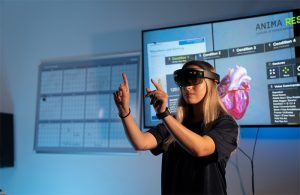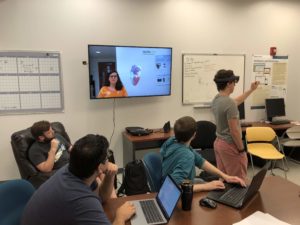AREA: Tell us how you became interested in joining the AREA.
Dr. Chaparro: I first heard
about the AREA from Brian Laughlin at Boeing. Brian was my human factors
doctoral student when I was at Wichita State and we’ve kept in touch over the
years. I’ve seen the kinds of things he’s been working on at Boeing and how it
overlapped with my research interest in human/computer interaction and usability
and user experience. I saw an opportunity to pursue them further through the
AREA group.
AREA: Could you tell us more about your background as it relates to AR?
Dr. Chaparro: My background is
in the area of usability and user experience. I have worked with a number of
different companies and technologies focusing on implementing design principles
to make it as easy as possible for people to use devices and tools.
I became interested in AR when
Google Glass was introduced. I could see the potential in industries such as aviation,
medical, and consumer products. My initial interest with Glass was to use it as
a training tool for my students. I also worked with a colleague at Wichita
State to study user interactions with Glass versus a cell phone.
And then HoloLens came out, and
for a year and a half now, we have been exploring the user experience side of
HoloLens. We want to get an idea of how the average person experiences this
technology. For instance: What are some of the issues from a UX standpoint? The
gesturing, window manipulation, texting, voice input – all of these methods of
interaction bring usability and user experience issues to the human-technology
interaction. A lot of the literature is focused on the usability of a particular
app, but there is very little out there on the integration of multiple technologies,
working across a multitude of tasks at the same time, or task-switching between
the physical and augmented environment. That is my interest, and then seeing the
application of this to a variety of domains. I consult, for example, with
healthcare professionals who believe that AR has great potential. Whatever the
domain, there is going to be this core issue of usability that will determine whether
it takes off or not. Eventually, it comes down to the comfort and the seamlessness
of the user experience in the tasks that they are doing.
AREA: How do you expect to benefit from your membership in the AREA?
Dr. Chaparro: I see the AREA as
a fantastic mix of academic researchers and industries that are applying the
technology. Human factors is an applied field, so we’re always looking for
practical applications of the things we’re studying in the lab. So I see that
as a huge benefit of the AREA. Then we’ll benefit from the work of the various
committees. We’ve been participating in the Safety and the Research Committees,
and hopefully, the Human Factors Committee in the future. We need to understand
what the issues are, because any problem that an industry is having is a potential
research project for one of my students. And that’s the other benefit: to
recognize the needs of industries that will need to hire students that have
knowledge of this technology. We want to understand what those needs are so we
can build them into our curriculum if they are not already there.
AREA: Based on what you have learned so far, what do you see as the
major outstanding issue that needs to be addressed to make AR more usable to
the average person?
Chaparro: With these new
glasses and head-mounted devices, certainly comfort is an issue, especially in
industries where they will need to wear them for an extended period of time.
That’s going to be huge. And not from just a comfort standpoint but also visually
– going back and forth between the physical and augmented world and what that
experience is like.
AREA: In addition to the research projects you mentioned, what other
areas of AR are being explored at Embry-Riddle?
Chaparro: My colleague Dr. Joseph
Keebler has been conducting research related to marker-based AR in medical
training. His area of expertise is medical human factors, teams, and training, so
he is excited about the technology from both a training standpoint and as a
real-time use tool for high performing teams. The issue is that, while it
appears that this technology is great and effective, we really need more research
to demonstrate how and when it is working, and how to best integrate it into
modern day systems.
One challenge is that there’s
a novelty effect problem. For instance, there are research projects being done
that show AR is better for performing a task, but it is really hard to tease
away the novelty side of that. In other words – are people improving due to
increased learning from the AR system? Or is it simply the fact that it’s this
fascinating and visually impressive technology that is garnering people’s
interest and keeping them engaged? Joe and I are interested in how to structure
a study so that we are looking at the true effectiveness of the technology above
and beyond the effects of its potential novelty. Joe has published a few papers
on AR, including a chapter in the Cambridge Handbook of Workplace Training and
Employee Development (Keebler, Patzer, Wiltshire, & Fiore, 2017)[1].
Another one of our colleagues,
Dr. Alex Chaparro, has been working on the use of AR in transportation. For
example, AR has many applications in aviation, maintenance documentation, and
driving environments. His main interest is in the uses of AR and VR in these environments
to train individuals to perform complex tasks.
We also have a VR gaming lab.
Joe and I have also done some psychometric work on the validation of a new
satisfaction instrument for video games that we’re now trying to apply to the
AR world (Phan, Keebler, & Chaparro, 2016)[2]. We
definitely see the benefits of this technology and would like to see it
succeed.
[1] Keebler, J. R., Patzer, B. S., Wiltshire, T.
J., & Fiore, S. M. (2017). 12 Augmented Reality Systems in Training. The
Cambridge Handbook of Workplace Training and Employee Development, 278.
[2] Phan, M. H., Keebler, J. R., & Chaparro, B. S. (2016). The
development and validation of the game user experience satisfaction scale
(GUESS). Human Factors, 58(8),
1217-1247.


